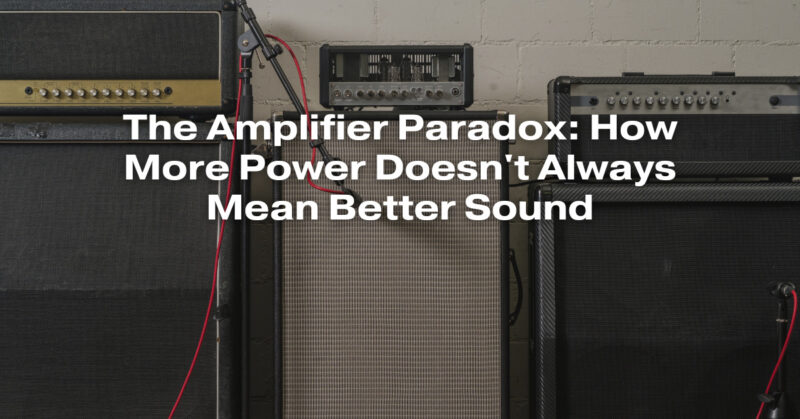In the world of audio amplification, the belief that “more power equals better sound” is a common misconception. While it’s true that a powerful amplifier can provide ample volume, the relationship between amplifier power and sound quality is more complex. In this article, we’ll explore the amplifier paradox, debunking the notion that greater power always results in superior sound, and highlighting the factors that truly influence audio quality.
The Power vs. Sound Quality Misconception
The idea that a high-wattage amplifier automatically delivers better sound quality can be misleading. Here’s why:
- Distortion: As an amplifier’s power output increases, it becomes more capable of producing higher volumes. However, when pushed to their limits, amplifiers can introduce distortion, which degrades sound quality. Clipping, a form of distortion, occurs when an amplifier can’t cleanly reproduce the audio signal, resulting in harsh and unpleasant sound.
- Inefficiency: High-power amplifiers tend to be less efficient at lower volumes. They may require a higher volume setting to achieve optimal performance, making it challenging to enjoy good sound quality at lower listening levels.
- Matching Components: The effectiveness of an amplifier also depends on how well it matches with other components in the audio system, including speakers and source equipment. A mismatched system can result in sound quality issues, regardless of amplifier power.
Factors Affecting Sound Quality
Rather than focusing solely on amplifier power, consider these key factors that influence sound quality:
- Speaker Efficiency: The efficiency of your speakers is crucial. Higher-efficiency speakers can produce a given volume with less amplifier power, reducing the risk of distortion.
- Amplifier Quality: The quality of the amplifier circuitry, components, and design plays a significant role. A well-designed, lower-power amplifier can often outperform a poorly designed, high-power one in terms of sound quality.
- Room Acoustics: The acoustics of the listening environment greatly impact sound quality. Room reflections, absorption, and placement of speakers and furniture all contribute to the overall listening experience.
- Source Material: The quality of the audio source, whether it’s a digital file, vinyl record, or streaming service, affects sound quality. A high-quality source can reveal more detail and nuance in the music.
- Listener Preferences: Ultimately, sound quality is subjective and varies from person to person. Some listeners may prefer a warmer sound, while others prefer a more analytical or detailed sound signature.
Matching Amplifier Power to Your Needs
To achieve optimal sound quality, it’s important to match the amplifier’s power to your specific needs:
- Speaker Matching: Choose speakers that have a sensitivity rating that complements your amplifier’s power output. This ensures efficient power utilization and minimizes the risk of distortion.
- Listening Levels: Consider your typical listening levels. If you rarely listen at high volumes, a lower-power amplifier may be more suitable and cost-effective.
- Room Size: Larger rooms may require more powerful amplifiers to fill the space with sound effectively. Conversely, smaller rooms may not benefit as much from high-wattage amplifiers.
- Quality Over Quantity: Prioritize amplifier quality over sheer power. A well-designed, lower-wattage amplifier can deliver exceptional sound quality without the risk of distortion.
Conclusion
The amplifier paradox challenges the notion that more power always equates to better sound quality. While amplifier power is important, it’s just one of many factors influencing sound quality. A well-matched, high-quality amplifier can provide a superior listening experience, even at lower power levels. Instead of chasing the highest wattage, consider the synergy between your components, room acoustics, and personal preferences to achieve the best possible sound quality for your audio system.


